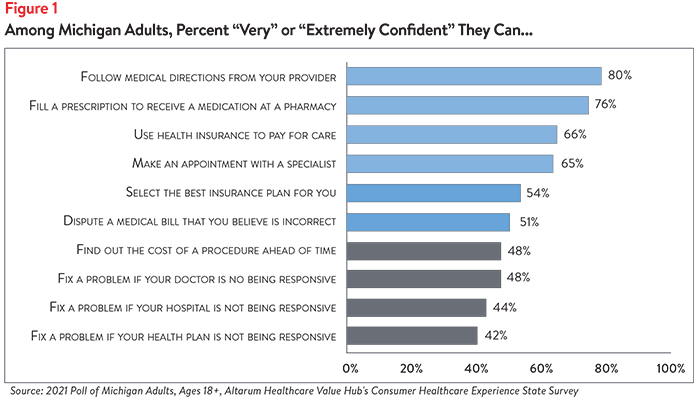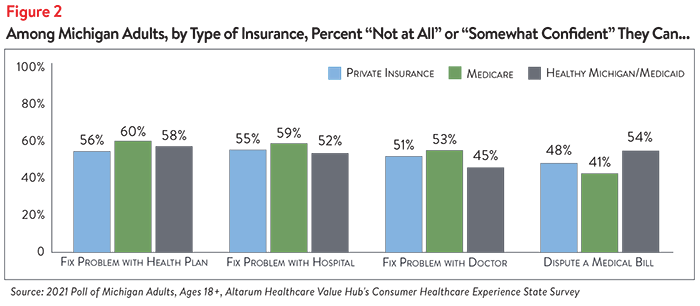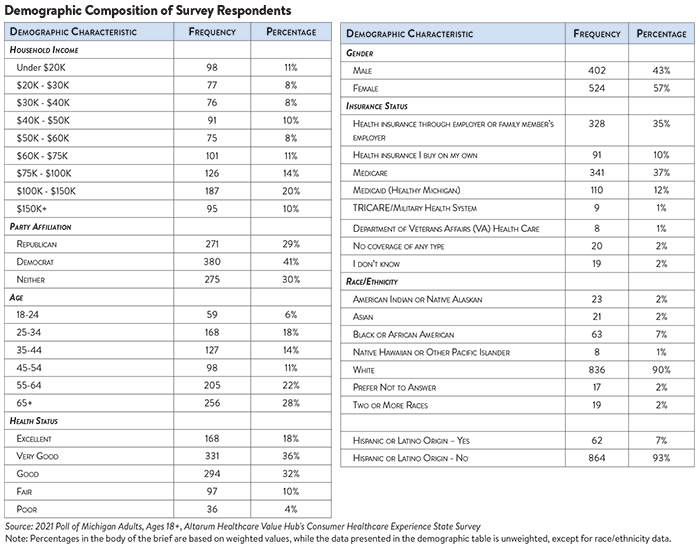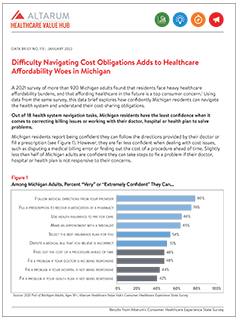Difficulty Navigating Cost Obligations Adds to Healthcare Affordability Woes in Michigan
A 2021 survey of more than 920 Michigan adults found that residents face heavy healthcare affordability burdens, and that affording healthcare in the future is a top consumer concern.1 Using data from the same survey, this data brief explores how confidently Michigan residents can navigate the health system and understand their cost-sharing obligations.
Out of 18 health system navigation tasks, Michigan residents have the least confidence when it comes to correcting billing issues or working with their doctor, hospital or health plan to solve problems.
Michigan residents report being confident they can follow the directions provided by their doctor or fill a prescription (see Figure 1). However, they are far less confident when dealing with cost issues, such as disputing a medical billing error or finding out the cost of a procedure ahead of time. Slightly less than half of Michigan adults are confident they can take steps to fix a problem if their doctor, hospital or health plan is not responsive to their concerns.

Many respondents reported low confidence in their ability to solve problems with their doctor, hospital or health plan, regardless of insurance type (see Figure 2).

This data supports findings that many respondents are not taking actions that may ultimately resolve problems like unexpected medical bills. Among those who received unexpected medical bills in the past 12 months, a notable share (15%) reported paying the bill without disputing it. Slightly less than half reported taking initial steps like contacting their health plan (49%), or contacting their doctor, hospital or lab (45%), but very few took additional steps such as contacting a consumer assistance program (18%), filing an insurance appeal (5%) or contacting a state government agency (5%). Ultimately, 41% report being dissatisfied with the resolution of their surprise bill.
Michigan Residents Lack Confidence in Finding Healthcare Prices, but Those Who Try are Usually Successful
Slightly less than half (48%) of Michigan adults are confident they can find the price of procedure ahead of time (see Figure 1). Lack of confidence may contribute to the lack of respondents who report trying to find out-of-pocket costs ahead of time (all under 50%), with the notable exception of prescription drugs (see Figure 3). Seeking the cost of a medical test and hospital stay were least commonly reported among the options provided, with 42% and 37% of respondents reporting taking this action, respectively.

Fifty percent of survey respondents who sought prices only performed this activity once or twice. Almost two-thirds (63%) of these shoppers report seeking prices in order to compare two or more services – a rate higher than previously observed in national surveys. Among those who attempted to compare prices, 84% report that they were successful.
Health Plan Cost-Sharing Terms Are Difficult to Understand
While some respondents do try to find prices in advance, consistently understanding cost-sharing obligations remains challenging for Michiganders.
When given multiple choices, the Michigan poll revealed that respondents were able to choose the correct definitions for Premium and Deductible around 70% of the time, but less than half had an accurate understanding of Coinsurance (see Figure 4).

This aligns with national studies finding that health plan cost sharing terms are very difficult for consumers to understand. Reasons for this include complex insurance rules, poor numeracy skills and poor literacy skills.2 Information related to patients’ out-of-pocket costs was rated as the most challenging to find and understand out of all healthcare information.3
Unfortunately, national data suggests that consumers are not good self-reporters when it comes to assessing their skills. Myriad studies show that confidence typically exceeds actual skills, particularly when it comes to applying insurance cost-sharing rules to understand the amount patients have to pay.4
Relationship Between Quality and Price
Studies show there is little relationship between the quality and price of a medical service.5 This survey investigated Michiganders’ views on the relationship between quality and price.
Nearly two-thirds (63%) of Michigan adults believe that higher quality healthcare usually comes at a higher cost, yet few (25%) believe that a less expensive doctor is likely providing lower-quality care (see Figure 5).

Both cost and quality are important to Michigan’s healthcare consumers. Half (50%) of Michigan adults indicated that, if two doctors or healthcare providers had equal quality ratings, out-of-pocket costs would be a very or extremely important factor in deciding between the two professionals. A slightly higher share of respondents (57%) indicated that, if two providers’ out-of-pocket costs were equal, quality ratings would be a very or extremely important factor in deciding between the two professionals.
Discussion
While some Michigan residents are willing to seek out-of-pocket cost data (selectively), they may have conflicting views on the relationship between the cost and quality of healthcare, and they also report lacking confidence in certain skills needed to navigate the healthcare system. Of the options provided, the most common struggles include successfully disputing medical bills and resolving problems with unresponsive providers, health plans and hospitals. These navigational challenges vary only slightly by insurance type, suggesting that these difficulties are universal among Michigan adults.
Additionally, difficulty understanding of concepts like coinsurance may make it difficult for some consumers to anticipate out-of-pockets costs and budget for healthcare expenses. Moreover, these difficulties can contribute to the receipt of “surprise medical bills” and worsen affordability burdens and worries for consumers.6
Consumer harm resulting from difficulty navigating the health system can be addressed in numerous ways. Evidence-to-date suggests that simplifying eligibility criteria and benefit design, among other aspects of our health system, are likely to yield better results than educational efforts alone. Simplification strategies include:
- Reducing the likelihood of encountering pricing or quality outliers;7
- Simplifying and standardizing cost-sharing benefit designs;8
- Providing “nudges” like integrated provider directories, quality rankings, and out-of-pocket calculators while health plan shopping;
- Providing live, hands-on assistance navigating health insurance issues; and
- Deploying “universal precautions” in communications.
Similarly, to the extent that the health system remains complex, consumers have signaled a preference for live, just-in-time consumer assistance, rather than passive educational materials.9 A few states have developed a one-stop-shop for helping consumers address denied claims or other difficulties.10
Notes
1. Michigan Residents Struggle to Afford High Healthcare Costs; Worry About Affording Future Care; Support Government Action across Party Lines, Data Brief No. 114, Altarum Healthcare Value Hub (January 2022).
2. Long, S. et. al. Low Levels of Self-Reported Literacy and Numeracy Create Barriers to Obtaining and Using Health Insurance Coverage The Urban Institute, October 2014.
3. Duke, Chris, The Challenge of Communicating Health Care Information Effectively, Altarum Institute (Aug. 22, 2016) and Quincy, Lynn, What’s Behind the Door: Consumers’ Difficulties Selecting Health Plans, Consumers Union (January 2012).
4. Paez, Kathryn, and Coretta, Mallery, A Little Knowledge Is a Risky Thing: Wide Gap in What People Think They Know About Health Insurance and What They Actually Know, American Institute for Research (October 2014); Loewenstein, George, et al., “Consumers’ Misunderstanding of Health Insurance,” Journal of Health Economics (June 26, 2013).
5. Hussey, Peter, Samuel Wertheimer and Ateev Mehrotra, “The Association Between Health Care Quality and Cost: A Systematic Review,” Annals of Internal Medicine (January 2013).
6. Michigan Residents Struggle to Afford High Healthcare Costs; Worry About Affording Future Care; Support Government Action across Party Lines, Data Brief No. 114, Altarum Healthcare Value Hub (January 2022).
7. Vestal, Christine, One State’s Hospital Cost Solution: Regulated Prices, The Pew Charitable Trust, Washington, D.C. (March 2011).
8. Altarum Healthcare Value Hub, Improving Value: Standard Benefit Design (accessed on Jan. 6, 2022).
9. Tolbert, Jennifer, et al., Connecting Consumers to Coverage: Lessons Learned from Assisters for Successful Outreach and Enrollment, Kaiser Family Foundation (Sept. 19, 2014).
10. The Office of the Healthcare Advocate: Giving Consumers a Seat at the Table, Research Brief No. 25, Altarum Healthcare Value Hub (May 2018).
Methodology
Altarum’s Consumer Healthcare Experience State Survey (CHESS) is designed to elicit respondents’ unbiased views on a wide range of health system issues, including confidence using the health system, financial burden and views on fixes that might be needed.
The survey used a web panel from Dynata with a demographically balanced sample of approximately 1,000 respondents who live in Michigan. The survey was conducted in English or Spanish and restricted to adults ages 18 and older. Respondents who finished the survey in less than half the median time were excluded from the final sample, leaving 926 cases for analysis. After those exclusions, the demographic composition of respondents was as follows, although not all demographic information has complete response rates:








